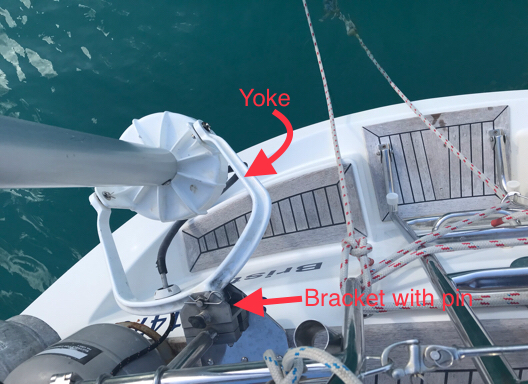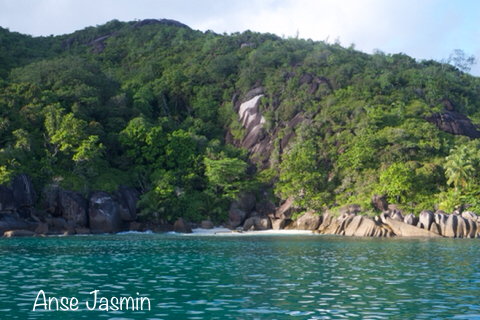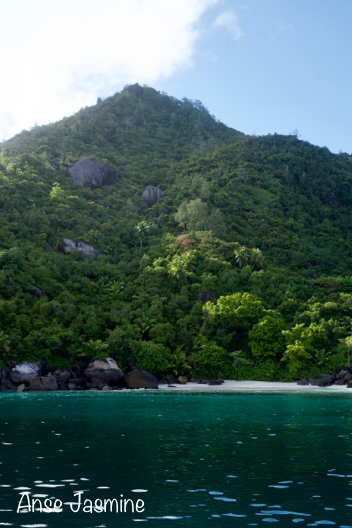Almost Ready to Leave

After a further period in the marina Annie and I have spent five nights on the other side of the island, in Baie Beau Vallon in the north west and Anse Jasmin just to the south. The Seychelles is a joy for cruising. Much more developed than, say, Vanuatu but most of the islands have beautiful bays to anchor in with gleaming white beaches, stunning granite rock formations and dramatic forested hillsides, with palm and acacia trees, steeply rising from the shoreline. It could hardly be more beautiful. Away from the centres of population the tourism is low key and may be little more than a makeshift bar at the beach. Perhaps helped by the topography the islands remain forested and several are protected areas. It is a joy being here. When at anchor in Anse Jasmin a large day trip catamaran came around from the adjoining bay and anchored for lunch. I was on deck and about to launch the dinghy when I noticed something truly enormous just below the surface of the water behind the catamaran. With a vertical tail fin just breaking the surface of the water it was clearly a shark and by my estimate around 20 feet long. Annie soon joined me and will vouch for my description. The crew on the catamaran saw it also and became very excited, jumping into their dinghy and motoring across to where it had swum at the edge of the bay. The huge shadow moved slowly past the dinghy and out into deeper water. We beckoned the dinghy across to us and the crew tried to tell us the creature was a whale. It clearly wasn’t but a precise identification from above the water wasn’t possible (by me anyway). That night in a sleepless moment I researched sharks of the Seychelles and discovered that in 2011 two people had been killed by a great white shark in the first bay we had anchored at on Praslin Island. The size of the shark, the fact that it appeared to have been following the catamaran and a white patch on its flank led me to believe that we had seen a great white. The thought certainly cooled Annie’s ardour for swimming off the back of the boat. Back at Eden Island where we are again at anchor I was telling my shark story to Jon over a beer when it occurred to me that the crew on the catamaran might have meant whale shark and not whale. Seemed unlikely but when researching further I also discovered that there is indeed a whale shark season in the Seychelles between September and December and that the best place to see them is Beau Vallon - where we were at anchor! So I will go with whale shark which, in whale shark terms, was actually quite a small one, and not let my imagination run away with me. Whilst in the marina we met up again with friends Ben and Ashley on their catamaran Nahoa. You may recall that Sailing Nahoa is a popular vlog with more than 350,000 regular followers. In fact the vlog is now in the top 10 YouTube sailing vlogs and the income from it is how Ben and Ashley make their living. They have had serious structural issues with their boat which they are in the process of rectifying. At the same time they are negotiating for a new build catamaran for which the builder is offering a big discount in return for the product placement in their vlogs. I have never really understood how this YouTube thing works as a career move or source of income but we are now seeing how. Ben and Ashley are feted like A list celebrities and while we were having supper on board Nahoa a young couple came by and couldn’t contain their excitement at meeting them. Supper was interrupted for selfies and animated eulogies. The only downside was that I offered to take pictures of the four of them and the excited couple assumed Annie and I were the parents. The fact that we are old enough to be so is beside the point. I keep reminding Annie we should have become vloggers with “Wrinklies Around The World”. The market is crying out for an alternative to beautiful and photogenic young things idyllically cruising their way around the world. My confidence that all was good with the equipment on Vega was misplaced! The alignment of the Duogen shaft when raised had been awry for a while but with no obvious cause had not been a great concern. However, once back in the marina we investigated further and found wear in the bracket that supports the yoke in which the alternator is held. There is a vertical pin that holds the yoke into the bracket and that allows the Duogen to swing sideways in water mode. The bushes supporting the pin had worn away and the bottom hole in the bracket had enlarged so that the pin was no longer held vertically. We took the bracket to an engineering workshop and all was made good. It was only when putting the Duogen back into the yoke we found that the arms of the yoke are bent out of alignment. It was this that was causing the misalignment of the Duogen and the wear in the supporting bracket. This gives rise to our current conundrum which is that the workshop is declining to bend the arms back into alignment, fearing the yoke will break. The manufacturer says that the yoke is made of a malleable aluminium alloy that can be bent back into alignment. If it did break there is no chance of getting a replacement in time for our passage but it might be possible to fabricate a stainless replacement - if I can find a workshop that will do it. The current decision is to leave until South Africa where we can try and bend it straight and replace the yoke if necessary. The Duogen will align overall in water mode but the supporting pins in the yoke are at an angle and will wear through the bushes fairly quickly. During our recent short stay in the marina we plugged into shore power and fired up the freezer again. It takes a long time to get down to minus 12 degrees so shore power is a good option - the batteries can cope thereafter. When on shore power (or using our on board generator) the mains powered battery charger automatically kicks in, except this time it didn’t. I hadn’t noticed this until disconnecting the shore power, which otherwise had worked fine. Philippe in town thinks he can repair the charger but it means removing it and getting it to him. It is not often we are on shore power and needing to charge the batteries so it is not an essential repair at the moment and again can wait until S Africa. Another non essential repair is replacing the engine control panel in the cockpit. This got overtaken by events in the marina due to an unfortunate (some may unkindly say idiotic) action on my part. We had used very little fuel getting to the Seychelles and refuelling was simply emptying the diesel from our spare containers into the tank and then refilling the containers at a local garage. We have seven 20 litre diesel containers in addition to the 230 litres in the tank. Three are kept on the side deck near the mast, three in a cockpit lazarette and one on the side deck in the pushpit at the stern. As we travel we use and refill the containers as and when required. Rarely do we use them all in one go and so we can have fuel from different sources in the various containers. Each source may have a surprisingly different colour and smell of diesel ranging from dark yellow and acrid smelling to clear and sweet smelling. A further complication is that we also carry 60 litres of petrol in three containers for the outboard motor and water maker. The petrol containers are red - as are two of the diesel containers (so you can see where this is leading). I am careful to label the red containers either “petrol” or “diesel” and to store them separately - diesel on the starboard side and petrol on the port. Having almost filled the tank with varying colours and smells of diesel I had one red container - clearly marked “diesel” - remaining. I fill the tank through a filter funnel and thought the final diesel looked rather orange in colour and smelt a bit petrol like but coming from a clearly marked diesel container must just be another variant. My logical mind said stop and double check but coffee and cake were ready and my inner “chimp” said to just quickly finish the job and enjoy the coffee as a well earned reward. Jon joined us for the coffee and later, after burning and smell testing, confirmed I had just put 15 litres of petrol into the tank. A similar mistake with a car cost me (my insurers actually) £8k to rectify. With an older engine 5% of petrol in the diesel would likely do no harm and it has been shown you can run an old diesel engine on petrol for a while and then put diesel back in and all is well again. Is this a risk worth taking with the Mozambique Channel coming up? No need to answer that so all the time we would have used to replace the engine control panel was taken emptying the fuel tank, with three trips to the garage for new fuel. The only helpful aspect was that the guy running a couple of old charter boats by us was happy to take the contaminated fuel that would otherwise have cost a small fortune to dispose of - plus the fact that we now have single source good quality diesel throughout. How the petrol got into a diesel container could be the source of endless and fruitless speculation but the lessons to avoid a repetition are clear. The major factor for getting down to Mayotte from Seychelles is the compression zone at the top of Madagascar where the south east trade wind is deflected by the island northwards, squeezing it together with the trade wind further north. This zone of compression has wind of 30 to 35 kts and 3m waves as the norm. High pressure to the south enhances the effect, low pressure reduces it. So, what we are looking for is a low pressure system to come across from west to east below South Africa and Madagascar, reducing the trade wind and this compression zone that we have to cross. Unfortunately there has been a consistent run of high pressure systems and there has been no indication that this is likely to change anytime soon. So we either sit things out and wait or brace ourselves for two or more rough days crossing the compression zone. We don’t want to be leaving Mayotte for South Africa much later than mid October after which the south eastern monsoon falters before the onset of the north west monsoon with lighter wind but with the onset of big coastal thunderstorms (my biggest fear). As it happens we have today noticed that a big low pressure system is forecast to pass to the south of Madagascar next weekend. We will keep monitoring the situation and if things develop as currently predicted we will head south on Thursday or Friday. Since leaving Thailand we have met two sailors - Glenn (British) in the Maldives and Kim (Danish) here in the Seychelles. Both have headed single handed for the Red Sea and both have abandoned their boats following gear and mechanical failure in rough weather and been picked up by a cargo ship. Kim is currently on his way to India. Although comfortable that Vega is sound and well prepared I would rather avoid bad weather if at all possible!      |